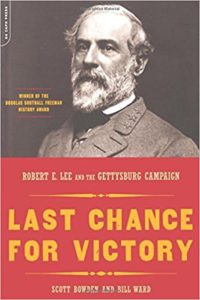As I mentioned in a couple of prior posts, I recently finished a book about General Robert E. Lee’s Gettysburg campaign. In that book, Last Chance For Victory, the authors speak much about the second day of the battle. The first day was also covered extensively, though the third somewhat less than the first two. On the first day, the Confederate army and the Union army met almost accidentally at Gettysburg. A major clash wasn’t expected quite that soon by Lee. So the ebb and flow of the battle had to do with standing orders for both sides, and with soldiery and generalship, and less to do with strategy.

But, on the second day, it was all about strategy and tactics. So say Bowden and Ward, the authors of LCFV. Lee spent much of the night of July 1-2 working on his strategy, even before he knew for sure what the Federal positions were and which of his own forces would be available for battle. He consulted with his corps commanders: Longstreet, Hill, and Ewell. They had ideas of what to do, especially Longstreet. Lee considered that, then set a plan for a frontal attack from the west against Cemetery Ridge, held by the Union. A “demonstration” in force by Ewell’s corps from the north was also part of it, which Lee meant to develop into a full attack, depending on how the Union reacted. These plans took most of the morning to prepare, and were to launch in the early afternoon.
But, when Lee and others made a final check of the front. It was discovered that General Sickles, a corps commander for the Union, had moved his corps down Cemetery Ridge into a forward position along the Emmitsburg Road, over a mile closer to the Confederates. And, his new line had a “kink” in it; it wasn’t a nice straight line as armies are used to forming. It also left the Union susceptible to flanking movements, either around Sickles to the south or between Sickles and the next corps, commanded by General Hancock.
Bowden and Ward say this was a stupid move on Sickles’ part. This is echoed in other accounts that I’ve read, limited as they are. Sickles was too exposed, his new line too hard to defend. Yes, it was a stupid. The results of the battle “prove” this true. Sickles’ corps was decimated by Lee’s attack. They fell back—the ones that weren’t killed, injured or captured. That stupid Sickles cost the Union a functioning corps.
Except, because of Sickles’ move, Lee changed his battle plan. Instead of a full, frontal attack simultaneously by two corps, he went with an en echelon attack, that is, an attack that progressed from one end of the line to the other, not simultaneously, but sequentially, division by division or brigade by brigade. This took an hour or so to put together and issue new orders. Thus, the Confederate attack didn’t kick off until about 4:00 in the afternoon. It went well, but fell apart as dark was approaching, giving Lee no time to take corrective action.
So Sickles’ move cost the South about an hour of battle daylight. Lee famously said that they needed another half hour to make the attack successful. Why didn’t he have the time he needed? Because of Sickles’ move. So, even though his corps took heavy, heavy casualties, wasn’t his move what saved the day for the Union?
Bowden and Ward didn’t discuss the time factor, the time Sickles’ took away from Lee by changing his position. Yes, his casualties were heavy, but it seems to me it was the key move by either army in the whole sequence of the three-day battle. While Lee was adjusting his strategy and orders, the Federal army was able to bring up more troops that were arriving, and make other adjustments. Also, troops badly beaten the previous day had an extra hour to get their act together. Many were still not battle-worthy, but with an extra hour of rest, and time for their officers to rally them, they had to be in better shape at 4:00 p.m. than they would have been at 2:00 p.m., when the battle might have kicked off according to Lee’s original plan.
So, was Sickles’ move folly, or genius? Everything I’ve read says it was folly. Is their no one among the battle’s historians who see this as a good move—a costly move, but a good one in that it bought time, time that the Union desperately needed. Who am I to question military historians, a novice such as I am?
I have much more reading to do on this to know for sure. And, I don’t know that that time will ever present itself for me to be able to do this. I hope, some year, I’ll get to read more on it, and maybe write something from more knowledge.